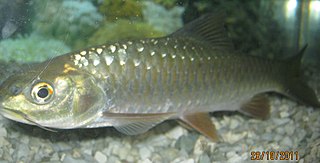
A tuna is a saltwater fish that belongs to the tribe Thunnini, a subgrouping of the Scombridae (mackerel) family. The Thunnini comprise 15 species across five genera, the sizes of which vary greatly, ranging from the bullet tuna up to the Atlantic bluefin tuna, which averages 2 m (6.6 ft) and is believed to live up to 50 years.

Mackerel is a common name applied to a number of different species of pelagic fish, mostly from the family Scombridae. They are found in both temperate and tropical seas, mostly living along the coast or offshore in the oceanic environment.

Herring are various species of forage fish, belonging to the order Clupeiformes.

Hemiculter is a genus of freshwater ray-finned fish belonging to the family Xenocyprididae, the East Asian minnows or sharpbellies. The species in this genusare found in eastern Asia from Siberia to Viet Nam. The type species is the sharpbelly, Culter leucisculus. The name is derived from the Greek word hemis, meaning "half", and the Latin word culter, meaning "knife".

The sharpbelly or wild carp, sharpbelly, or common sawbelly, is a tropical freshwater and brackish water fish belonging to the family Xenocyprididae. It originates in large streams and reservoirs in China, Taiwan, Japan, Hong Kong, Korea, and the Amur River basin. It has become established as an exotic species in several other countries, including Iran, Afghanistan, and the former Soviet Union, where it has displaced local species. It was originally described as Culter leucisculus by S. Basilewsky in 1855, and has also been referred to as Chanodichthys leucisculus and Hemiculter leucisculus warpachowskii in scientific literature.
Hemiculter elongatus is a tropical freshwater fish belonging to the family Xenocyprididae. It is known only from the Ky Cùng River in Lang Son Province, northern Vietnam. It was originally described by Nguyen & Ngo in 2001.

Anabarilius macrolepis is an extinct species of freshwater ray-finned fish belonging to the family Xenocyprididae, the East Asian minnows or sharpbellies. This species was endemic to Yilong Lake in Yunnan, China. It is believed that it became extinct when Yilong Lake dried up in 1981, as a result of water abstraction for agriculture. The species was not observed in 1983–84, and was declared extinct in 2011.
Anabarilius yangzonensis is a species of freshwater ray-finned fish belonging to the family Xenocyprididae, the East Asian minnows or sharpbellies. This species is currently critically endangered by the International Union for Conservation of Nature. A. yangzonensis is endemic to Yangzong Lake of Yunnan, China.
Anabarilius qiluensis s a species of freshwater ray-finned fish belonging to the family Xenocyprididae, the East Asian minnows or sharpbellies. This species is endemic to Qilu Lake in Yunnan, but the it has not been recorded from that site since the early 1980s. Surveys conducted in 1983-84 failed to find thuis fish. In 1964 alien fish were introduced into the lake and prevented this species from reproducing, leading to its decline. The International Union for Conservation of Nature considers this species to be Critically Endangered, Possibly Extinct.
Hemiculter krempfi is a species of ray-finned fish in the genus Hemiculter. It is known only from the Cai River in Khanh Hoa Province and the Da Rang River in Phu Yen Province of central Vietnam. Here it is found mainly over sand substrates and is infrequently encountered in fish markets.
Hemiculter songhongensis is a species inquirenda of freshwater ray-finned fish which may belong to the genus Hemiculter.

Crossocheilus, also known as the fringe barbs, flying foxes, or "algae eaters", is a genus of fish in the family Cyprinidae. It is distributed in China, India, Indonesia, Malaysia and Thailand in Asia. These fish occur in several types of habitat, often fast-flowing rivers with rocky bottoms.
Hainania serrata, also known as the Hainan minnow, is a species of freshwater ray-finned fish belonging to the family Xenocyprididae. the East Asian minnows or sharpbellies. This fish is found in fast flowing hill streams in southern China and Vietnam. It is the only member of the genus Hainania.
Lepidopygopsis is a monospecific genus of freshwater ray-finned fish belonging to the family Cyprinidae, which includes the carps, barbs and related fishes. The only species in the genus is the peninsular hill trout, a species endmeic to India, weher it is restricted to the Periyar and lake in Kerala. The International Union for Conservation of Nature classifies this species as Endangered stating that it is threatened by invasive fish species, pollution and a dam.
Percocypris is a genus of cyprinid freshwater fishes found in large rivers and Fuxian Lake in the highlands of southern China and northern mainland southeast Asia. They are predators that mainly feed on smaller fish. They can reach up to around 50 cm (20 in) in standard length and more than 2 kg (4.5 lb) in weight.

Rohtee is a monospecific genus of freshwater ray-fiined fish belonging to the family Cyprinidae. the family which includes the carps, barbs and related fishes. The only species in the genus is Rohtee ogilbii, the Vatani rohtee, which is endemic to the northern Western Ghats in southern India.

Neolissochilus hexagonolepis, the copper mahseer, chocolate mahseer or katli, is a species of freshwater ray-finned fish belonging to the family Cyprinidae, the family which includes the carps, barbs and related fishes. This species is found in Nepal, eastern India, Bangladesh, Myanmar, Thailand, Malaysia and Sumatra. It may also be present in China and Viet Nam, also the record sof this species from the easyetn part of its range is uncertain and reports may be misidentifications.
Percocypris tchangi is a species of freshwater ray-finned fish belonging to the family Cyprinidae, the family which also includes the carps, barbs, minnowns and related fishes. It is found in the Salween and Mekong basins of Vietnam.









